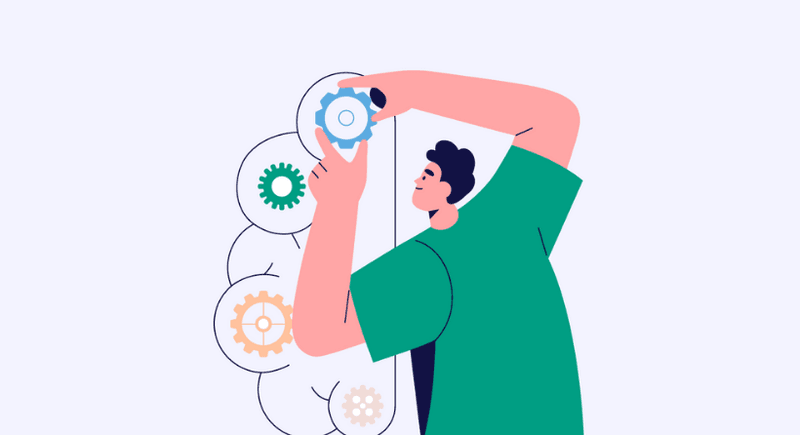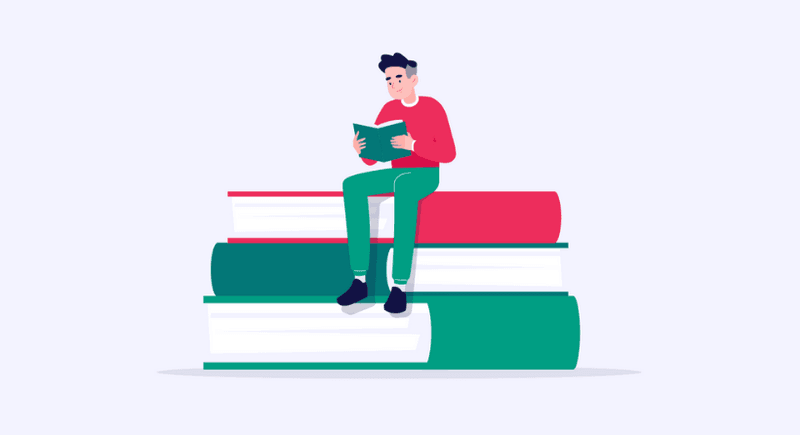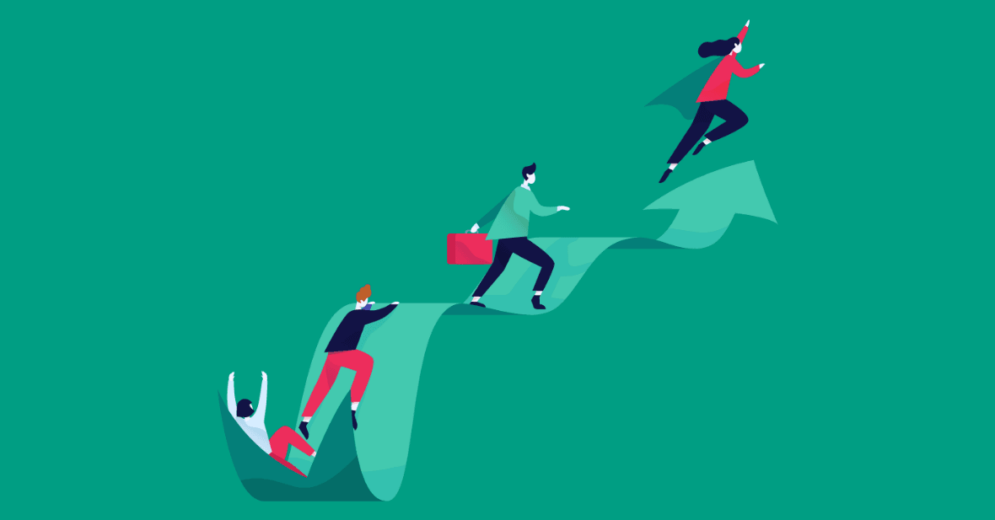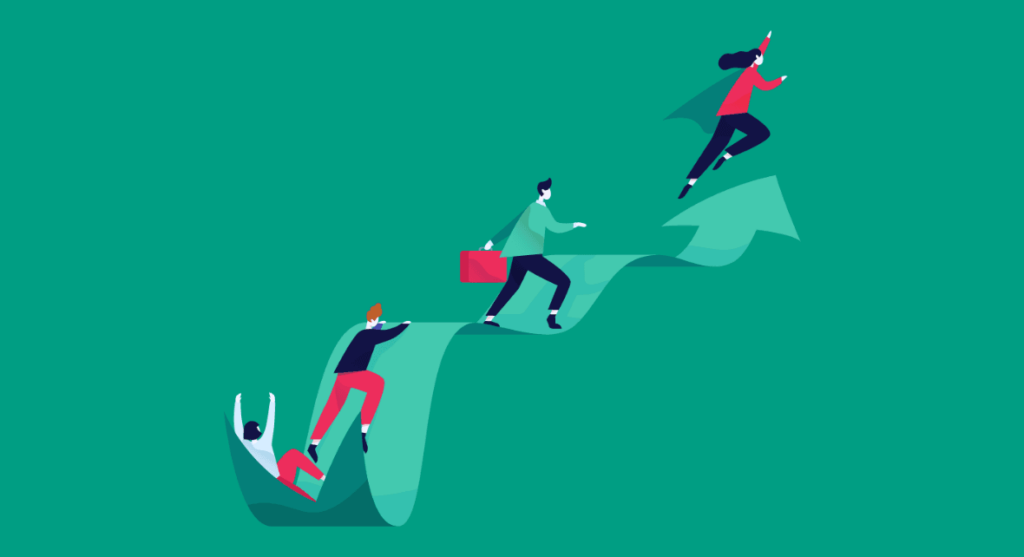Deciding to change careers and transition to a new profession is not easy. But UX Design has many opportunities, and a lot of people who have pivoted wish they had done it sooner.
However, it's common to feel uncertain about what the next steps should be after this initial decision.
After all, everything has a beginning, right?
That's why we have compiled a list of 10 essential steps to help guide you through the initial stages of transitioning to UX Design.
Let's get started!
1) Create an action plan to transition to UX
Excitement is a great ally when we want to venture into a change in our lives. Staying motivated makes all the difference, and staying that way as much as possible is important.
However, emotions alone are not enough to successfully transition to UX.
You need to have a plan and think of this change as a major life project.
Therefore, some points are important to be highlighted:
- Research about the career and the UX Design market; learn about the possibilities of working in UX;
- Talk to other people who have made the same move or read interviews with our students who have also changed careers;
- Create an execution schedule with an estimated deadline for completing the transition;
- Think about the financial aspect and the investments you will have to make;
- Be prepared for setbacks and unforeseen circumstances.
Sit down and write everything on paper. Compile all your research and the options you wish to pursue. Use this information to create a schedule that outlines the necessary actions for each stage of your plan.
After completing each stage, take time to reflect on what you have learned and the challenges you faced. This self-feedback will help you to refine your approach and improve your performance.
At the end of each stage, reflect on the learnings and challenges as if they were self-feedback.
Although your schedule serves as a guide, it is important to remain flexible and make adjustments as needed. It is perfectly acceptable to modify your plan or schedule when circumstances change.
Reading Tip: How To Use Storytelling To Promote Your Career
To inspire you: Aela's alumni who transitioned to UX Design
In our MID student community, we found some examples of people who planned to transition to UX and were able to achieve results very quickly. Check it out:
"Right in the beginning, I set a goal: in one year of study, I had to be in the UX/UI Design job market." – Vanessa Souza
"When I decided I wanted to focus on Product Design, I made a six-month plan to fully transition to the area. I focused almost entirely in the MID program, studying every day, and then I began to look for jobs in the field. I planned to get a job by March, but realized in February that my schedule would be delayed – I ended up getting a job in May." – Daiane Thomé
"I started studying in January 2018 and soon set clear rules for myself. One of them was to focus 100% on studies and set a goal that in 8 months I would be at level 3 and have improved my portfolio. I studied an average of 7 hours a day and took weekends off to rest." – André Borges
These students and many others achieved the long-awaited UX Design job within 1 year or less.
Therefore, we realize that having a plan is essential to organize your transition process to UX.
We cannot say that it is a rule because there are people who can transition without a well-structured plan. But establishing a plan and goals will surely help you a lot on this journey.
2) Get to know and develop the necessary skills

Just like any profession, UX Design requires people to have certain technical and behavioral skills.
However, when we talk about technical skills, it doesn't necessarily mean that you need to have a design background to transition to UX. In fact, the more diverse your background, the better.
But it is important to keep in mind that you need to develop certain skills to perform well in UX Design, such as:
- Research skills: given that an important area within UX is research, it is important to develop such a skill;
- Visual Design: mastering Visual Design is not fundamental, but it is essential to understand its basic concepts;
- Project management: understanding how to implement a project and how to manage activities and deliverables is essential in the life of a UX Designer.
We know that this list may be daunting, but don't worry. Technical skills are not impossible to learn. Therefore, if you realize that you need to familiarize yourself with some concepts, take time to study.
Soft Skills
In addition to technical skills (Hard Skills), it is important to understand that behavioral skills (Soft Skills) are also very important for you to be able to transition to UX Design.
However, if Hard Skills are "easier" to learn, Soft Skills take a little more time and experience in the market. This is because behavioral skills require more reflection and need practical experience to be strengthened.
Some of these skills are:
- Good communication: to establish a good understanding with your team and other stakeholders;
- Empathy: to understand the needs of the end user;
- Teamwork: because a team is formed from different people's profiles and maintaining performance is essential;
- Letting go: because your idea may not always be used.
At first, Soft Skills may seem easier to learn, but don't be fooled. It takes time and patience to perfect each one. However, you may already have them, having acquired them in other work experiences, even in areas other than Design.
Reading Tip: 9 Soft Skills to Stand Out as a Designer
3) Read books about UX Design
Studies are fundamental for those who want to transition to UX.
It is very important to read and study books and texts that explain the basic concepts of UX. Reading will give you a theoretical basis and, in addition, will open your mind to new ways of thinking.
We know that there are many great books, and it can be a bit confusing to know where to start your studies.
So, considering that, we recommend 3 basic and essential books for you to start understanding UX:
- The Design of Everyday Things – Don Norman;
- Rocket Surgery Made Easy – Steve Krug;
- Don't Make Me Think – Steve Krug.
The list above is just to get started. You should always seek new readings that can add to your learning process.
In addition to books, you can always turn to free content on the internet.
On our Blog, you can find several articles about the market, concepts, and career in UX Design. Check it out!
4) Learn UX Design in practice
Reading books and articles is very important for your learning, but UX Design is a very hands-on profession. Therefore, there is no better way to improve your theoretical learning than by putting what you know into practice.
However, the first question that comes to mind is: if I want to transition to UX Design, how can I have practical learning?!
At first, it may seem that practice will only come from a formal job. But, in fact, there are some options. One of them would be through courses that emphasize the practical aspect of UX Design, with plenty of exercises.
That's how it works in our MID – Mastering Interface Design program. There, we teach the theoretical part and how to put it into practice, with many exercises at each level.
The MID program is comprised of 11 levels, and at the end of each, a practical exercise is proposed. From these exercises, our mentors provide feedback for the improvement of the exercise.
Reading Tip: The Dunning-Kruger Effect And Its Impact On Your Career
5) Build a UX portfolio

UX Design is a profession in which experience and past projects count a lot in a job interview, for example.
Therefore, building a portfolio is indispensable if you want to find good opportunities and also be able to switch to UX Design.
However, building a portfolio is not just about putting the final images of your projects in a link. Quite the contrary.
The portfolio should take into account all the lines of reasoning and research done during the process of constructing the solutions and final resolutions. It is essential that you demonstrate the arguments that make up the result.
But then, a question comes to your mind: how will I build a portfolio if I haven't worked as a UX Designer yet?
Don't worry! You can still build a portfolio even if you haven't worked for a company as a UX Designer.
You can use your own exercises and redesign studies to compose your initial portfolio. That is, put together "fake" projects, but work on them as if they were real. Build your line of reasoning, do the research, and showcase all of this in your portfolio.
It may seem naive to believe that companies could actually hire you just by presenting fictitious projects, but the truth is that this situation is quite common.
For inspiration: students who used exercises from the MID program in their portfolio and were hired in UX Design
Vanessa Souza
"…when I was still in level 2 in the MID, I started preparing my portfolio with some projects from levels 1 and 2."
Rodrigo Guilherme
"…my portfolio only had two UX works at the time, which were developed during the first 2 levels in the MID."
Joyce Almazan
"…I was able to put together a portfolio overnight. I combined 3 pieces plus a complete case, using the exercises from the MID program. I presented the portfolio and passed the process."
Fábia Coelho
"…during the program, I put together my portfolio through the proposed UX, interface, and redesign projects and the meticulous guidance of the mentors."
Gabriel Bezerra
"…I was already in the Mastering Interface Design (MID) program and put some works from the course that were much more complete and structured."
These are just a few examples, among many others, that show how you can put together your portfolio based solely on exercises and land a job in UX Design.
Reading Tip: Impostor Syndrome: Are We Really Incapable as We Think?
6) Find a mentor to help you transition to UX
A mentor is a person who can guide you, advising you on how you can improve in your professional life.
A mentor is like a facilitator in your process of transitioning to UX Design. It is not essential, but it will help you in many moments.
The mentor has a lot of experience in UX Design and can help you in various ways:
- Technical experience;
- Behavioral skills;
- Experience in projects and different challenges;
- A new look at your problem;
- Networking.
Therefore, finding a mentor is quite interesting from the learning point of view, mainly, but not exclusively, when you are transitioning to UX.
It is quite comforting to have this kind of help, especially at the beginning of this journey.
But where can you find a mentor?
The most common place to find a mentor is in the work environment itself. How about inviting that professional you admire for a coffee?
But there are other ways to find a mentor:
- Online communities;
- Courses and programs like the MID;
- Professional mentoring programs.
Although not essential, having a mentor to exchange ideas and experiences is extremely enriching.
7) Learn about some basic UX Design tools
When you are in the process of transitioning to UX, it is important to research and know some basic software to work with UX Design.
Having prior knowledge of these tools is not essential; you can switch to UX from scratch since you will get to learn many tools in the day-to-day of the profession and according to the project's needs and the company you are working for.
However, it is important to note that there are UX Designer routine tools that you eventually need to know.
But which tool should you know?
Well, it all depends on which area of UX you want to pursue. First, be well aware of these possibilities, and then start looking for specific tools for this area.
However, there are some basic software programs that are worth mentioning:
- Sketch;
- Adobe XD;
- Photoshop;
- Axure;
- Invision.
Remember that to transition to UX you don't need to master each of these tools. In fact, you will learn how to use them during your work routine, the famous “learn by doing”. But it's interesting for you to start familiarizing yourself with them.
Reading Tip: Interface Design: 9 Tips for Building User Confidence
8) Don’t stop studying

UX Design is a very dynamic profession. New ideas and trends emerge rapidly.
Although the basic concepts of UX remain unchanged, it is important to always stay up-to-date with the market, new practices, new tools, and solutions.
Always seek quality content, paid or free, so as not to become too laid back and end up becoming outdated.
As you progress in the field, you will begin to hear about lectures, workshops, and conferences. These events are also very important for you to update yourself and learn new things.
For example, the Nielsen Norman Group promotes the UX Conference. This event offers various workshops and lectures on many topics within UX Design.
The UX Conference is a reference in the world of UX Design.
Our mentors have participated in several editions of the UX Conference and they share everything they learned in the community. Keep up with the latest in UX Design by visiting the Aela blog. Our expertly crafted content will help you transition to UX and take your career to new heights.
Don't forget to subscribe to our newsletter to stay in the loop and never miss out on valuable insights.
9) Networking
Establishing a network of contacts is essential in any profession, and it's no different in UX Design.
Networking is a very important step that not only helps you transition to UX but also to be in the know of new opportunities even when you're already established in the field.
Therefore, strengthen your contacts and get closer to other UX professionals. This exchange of experiences and ideas is fundamental not only to creating new opportunities but also to contributing to your learning process.
To work on your networking, you can:
- join UX Design communities;
- go to fairs and events related to UX Design;
- take a course that allows interaction with other students.
As an example, in the MID program, our students have a community where there is an exchange of experiences and help. In addition, many job opportunities are shared within our community.
For inspiration: networking of the MID students
"Diogo, another MID student, posted the job opening in our community, and I decided to apply. I had an interview with him on a Friday, and sent the tests I did during the weekend. And the following Tuesday I already received the result that I had passed." – Vanessa Souza
"The second opportunity came from networking with people I met during my transition process to UX Design. I became friends with someone who was also in the UX field. He helped me with a lot of advice, in developing myself in the profession, and he even let me know about job openings. After a while, he referred me to a UX Designer position…" – Nicole Marinho
"At these events related to Design and entrepreneurship that I participated in, I had the opportunity to make contact with several people. Through one of these contacts, I received a referral for this position at the startup Alfred Delivery." – Alyson Ambrosio
"[What has] the most value for me is the Aela community. Being able to exchange experiences, the motivation and positive energy that go around when someone lands a nice job, especially abroad, is really cool and encourages you to continue studying." – Alyson Ambrosio
"… a colleague of mine contacted me saying that there was an open position for UX Designer at Wunderman Brasil, an advertising agency where I had previously worked. Since I knew the work environment and the people, I decided to hit two targets with one shot and chose to participate in the process." – Joyce Almazan
10) Use LinkedIn

LinkedIn is a great tool for strengthening your network, looking for job openings, and transitioning to UX.
Several students report being contacted by recruiters and company managers through LinkedIn to participate in UX Design selection processes.
However, although it may seem simple to use, there are some important tips for you to achieve professional results with this social network:
- LinkedIn is not an entertainment network, so be careful with what you post. Limit yourself to professional content;
- Take LinkedIn SEO into consideration to reach more people and recruiters interested in profiles like yours;
- Organize your profile in a striking way. Remember that it is like your virtual resume;
- Make a cover letter on your profile;
- If you are looking for international vacancies, remember to put your profile in English.
Another important point is to always keep your profile up to date.
Create a profile to show your interests, skills, and experience. Don't limit yourself to using LinkedIn only to look for job openings.
Reading Tip: LinkedIn for Designers: Tips to Boost Your Profile
What type of person can transition to UX Design?
We know that the desire to change to UX is quite high, after all, UX Design is an incredible profession.
However, UX Design has its own traits, and having a profile that fits the profession does make the transition process easier. Not fitting this profile doesn't make it impossible to transition, let's be clear about that.
But we think it's relevant to list the most common characteristics among UX Designers for you to reflect on how much you fit into this pattern.
The idea is to provide an overview for you to understand which people best identify with UX Design.
Lovers of good Design
Nothing is more obvious for a UX Designer than loving good product designs.
But what is good design? It's not just a bold design in colors and shapes. It's also a design that brings functionality and a good experience to the user.
If you're the type of person who likes functional designs that make people's lives easier, UX Design will provide that for you.
Solution seekers
The UX Designer is the type of person who likes to seek solutions and solve all kinds of problems.
In UX projects, you will come across many obstacles. Whether in the User Journey or in the product's functionalities.
As a UX Designer, you have to bring creative solutions to overcome these obstacles and develop a functional product for the user.
Organized
The day-to-day of a UX Designer is quite dynamic. They work with a lot of research, analysis, prototypes, and meetings. Therefore, it is essential that you are an organized person because, in UX, disorganization brings unproductivity and waste.
Curious
As seen above, one of the steps you should take to transition to UX is to never stop studying.
And one of the characteristics of someone who likes to study is the curiosity for new learning.
Thus, UX designers are curious people at their core. They seek new knowledge to create new solutions and new ways of developing their projects.
Persistent
Persistence is a characteristic that is quite present in the UX Designer's profile.
In projects and in the search for the best solutions for the user, the process of trial and error happens frequently. Success does not come on the first try.
That is why being persistent and not giving up easily is an essential characteristic in UX Design.
Reading Tip: Persona: Why Is It Essential for Any UX Design Project?
What are the main fears that prevent you from switching to UX?
Every change involves fears and insecurities, and it is normal to experience them when changing to UX, as it is a significant decision and a major change in your life. However, you cannot let these fears and insecurities prevent you from achieving your goals.
With that in mind, we have listed the four main fears that may arise and explained why you should not let them paralyze you.
1) I don't have the background to transition to UX
This is probably the most common fear for those who want to transition to UX.
However, it is a fear that is not real, as it is not necessary to have a specific background to transition to UX.
In fact, a diverse background in other areas can be interesting, as it brings new skills to the UX Design process.
So, don't worry. Not having a background is not a hindrance to switching to UX.
Reading Tip: 5 Essential Competencies of a Product Designer
2) I don't want to pursue a new degree
A degree in UX Design is not essential for you to start working in the field.
In fact, more valuable than a diploma is having a good portfolio, as UX Design is a very practical area, and your experience counts much more than a degree.
So, do not worry. Although a degree is not necessary, it is always important to keep on studying and improving your skills in the profession.
3) I’m too old to transition to UX
Age is a concern that affects many professions and situations. Especially when we talk about a career change, the fear of age arises almost instantly.
But the truth is that there is no right age to transition to UX. In fact, there are cases of MID students who managed to switch after the age of 40:
The most important thing is the plan you have built to transition and your dedication to your studies. With that, age really doesn’t matter.
4) It will take too long to get my first job offer
Although experience counts a lot on a UX Designer's resume, the time it takes for people to get their first opportunity in UX is not that long.
The UX Design market is booming, and as a result, the number of job opportunities in the field is increasing more and more. That, combined with the awareness of the importance of UX, means that companies are increasingly investing in their UX Design teams.
So, don’t worry, because you might get your first opportunity fairly quickly. There are MID students who switched to UX in less than a year! Check out some examples and get inspired:
We hope that this article can help you better understand the main fears that arise when pivoting to UX, so that you can overcome them and achieve your goals. And if you need any more help or guidance, we are here!








